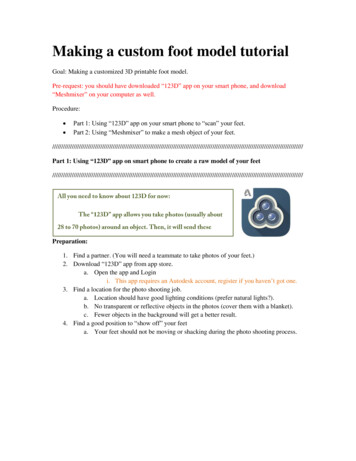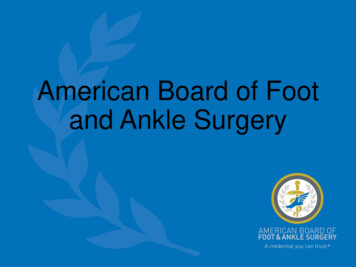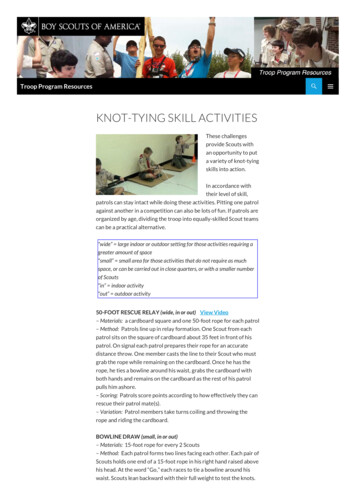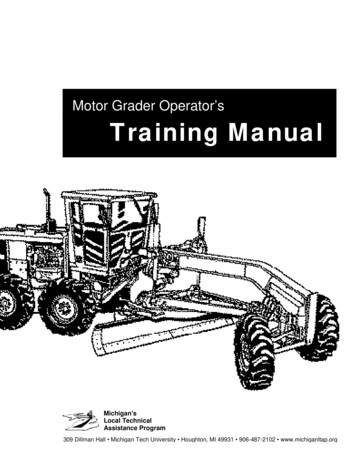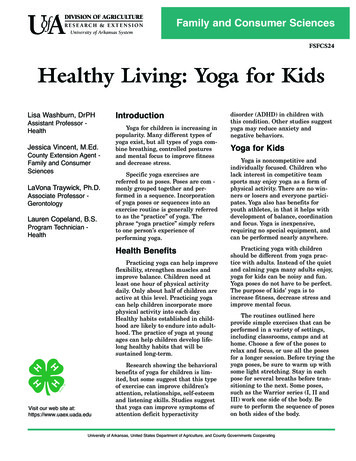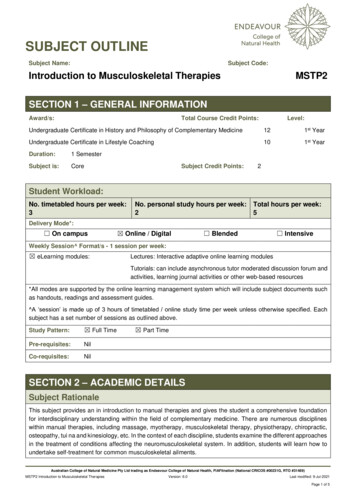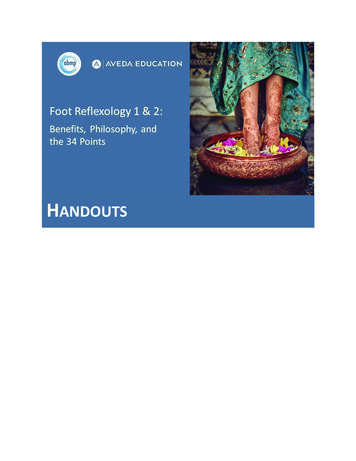
Transcription
HANDOUTS
627a27b27c27d27e2829diaphragmsacrumlumbar spinethoracic spinecervical spinethyroid and parathyroid glandsthroatpituitary glandpineal hymus glandlungslivergall blandderheartspleenstomachpancreasadrenal glandskidneysureterbladderascending colontransverse colondescending colonsigmoid colonrectumsmall intestinesciatic nerveFOOT REFLEXOLOGY CHART
3031323334uterus/prostateovary/testiclefallopian tubes/vas deferenslymphatic drainagebreastFoot Reflexology Chart 9/2016 Please recycle. Aveda Corp., Minneapolis, MN 55449-7106 USA 800.328.0849 / 763.951.6999 avedaeducation.com
Advanced Massage Techniques:Foot Reflexology IINTRODUCTION TO FOOT REFLEXOLOGYWHAT IS FOOT REFLEXOLOGY?Foot reflexology is the manual manipulation of the feet (i.e., massage) to stimulate, through subtle energy reflexes, the various parts ofthe body to promote health and well-being.BENEFITS OF FOOT REFLEXOLOGY Reduces stress Increases circulation Breaks up uric acid and calcium deposits on the reflex points Reduces muscle tension Feels goodNOTES:FOOT REFLEXOLOGY POINTS1. DIAPHRAGMThe diaphragm is the major breathing muscle. Just as the diaphragm stretches across the torso, the diaphragm reflex stretches across the foot.The main point of this reflex is located below the third toe. Massage the diaphragm reflex with the thumbs using effleurage motions. As theguest inhales, move the thumbs from the center point out. As the guest exhales, move thumbs to meet at the center point of the diaphragmreflex. Repeat three times.NOTE: The points of the feet are located similar to the way the organs and glands are located in the body. The diaphragm reflex separates thefoot into two parts: superior and inferior to the diaphragm reflex. Every organ in the body that is superior to the diaphragm is located distal toabove the diaphragm reflex, and every organ in the body that is inferior to the diaphragm is located proximal to below the diaphragm reflex.2. SPINEThe spinal reflexes are located along the inside arch of the foot. If you feel along the back of your neck and upper shoulders, the mostnoticeable bony protrusion is the spinous process of cervical vertebrae number 7 (C7). The area that protrudes the most on the foot is themedial base of the proximal phalange of the big toe. This is the reflex for C7. The spine has four natural curves—cervical, thoracic, lumbarand sacral. The inside arch of the foot has four curves that relate reflexively to the spinal curves. The sacral curve (Infinity/Air) is locatedalong the medial aspect of the calcaneus. The lumbar curve (Infinity/Air) is located along the medial aspect of the first cuneiform to thenavicular bone. The thoracic curve (Fire) is located along the medial aspect of the first metatarsal to the first cuneiform. The cervical curve(Water/Earth) is located along the medial aspect of the proximal phalange of the big toe. Massage the spinal reflexes with the thumbs usingeffleurage motions, moving from the heel toward the big toe. You may also use press-and-release motions. Use circular, friction motions onany tense areas. When massaging tense areas, pinpoint the curve of the spine (and even the vertebrae) on which you are working.NOTE: If people have flat backs, they might also have flat feet. Conversely, if they have an exaggerated arch in their back, they might have anexaggerated arch in their feet.1
FOOT REFLEXOLOGY POINTS CONTINUED3. THYROID AND PARATHYROID GLANDSThe thyroid releases hormones that help regulate metabolism, growth and development, and the parathyroids release hormones that helpregulate calcium and magnesium in the blood. The thyroid and parathyroid reflexes are located along the proximal phalange at the base ofthe big toe. Massage these reflexes using back-and-forth, friction motions.4. THROATThe throat reflex is located along the lateral aspect of the head of the proximal phalange of the big toe. Massage this reflex usingback-and-forth, friction motions.5. PITUITARY GLANDThe pituitary gland is the master gland of the endocrine system. It sends messages to the other glands of the body to regulate hormoneproduction. The pituitary gland reflex is located on the distal phalange of the big toe. To find this reflex, find the widest part of the big toe,move to the center and massage it using circular, friction motions. The best direction to massage this reflex is lateral to medial.6. PINEAL GLANDThe pineal gland is associated with the intuitive faculties of the brain, produces melatonin and helps the body adjust to the circadianrhythm. The pineal gland reflex is located distal to the pituitary gland reflex on the distal phalange of the big toe. Massage this reflex usingcircular, friction motions.7. SINUSESThe sinus reflexes are located on toes 2–5 in the same locations as the throat and pituitary gland reflexes on the big toe. Specifically, theyare located on the distal phalanges of the four toes. Massage these reflexes using circular, friction motions.NOTE: You can divide the foot into five zones that stretch from the toes to the heel. The first zone is the area from the big toe down to theheel; the second zone is the area from the second toe to the heel and so on. The first zone reflects the midline of the body; the secondzone is just lateral to the first zone and so on until the fifth zone, which is the most lateral. When you stimulate a reflex, you can use thezones to determine which part of the organ you are working on. For example, if you stimulate the sinus reflexes and the second toe is morecongested, the person is likely more congested at the midline, right around the nose. If the fifth toe is more congested, the congestion islikely more lateral, or below the eyes or temples.8. SHOULDERThe shoulder reflex is located distal to the diaphragm reflex on the lateral part of the foot at the fifth proximal phalange. It borders the soleand the side of the foot. Massage this reflex using circular or back-and-forth, friction motions.NOTE: All foot reflexology points relate reflexively with the body. When you stimulate the shoulder reflex on the right foot, you are workingon the right shoulder.9. ELBOWThe elbow reflex is located on the proximal side of the tuberosity of the fifth metatarsal. The tuberosity is the large, bony protrusion locatedat the base of the fifth metatarsal in the middle of the outside arch of the foot. This protrusion is quite useful in locating other reflexes.Massage the elbow reflex using circular, friction motions.10.HIP AND 11. KNEEThe hip reflex is located just proximal to where the cuboid and calcaneus bone meet, and the knee reflex is located distal to thelateral process of the tuberosity of the calcaneus. To find these reflexes, slide your finger down from tuberosity of the fifth metatarsal.The first indention you feel is the hip reflex, and the second indention you feel is the knee reflex. Massage the hip and knee reflexesusing circular, friction motions.12.EARSThe ear reflexes are located on top of the sole of the foot in the area between the fourth and fifth proximal phalanges and the third andfourth proximal phalanges. Massage these reflexes using circular or back-and-forth, friction motions.13.EYESThe eye reflexes are located on top of the sole of the foot in the area between the second and third proximal phalanges and the first andsecond proximal phalanges. Massage these reflexes using circular or back-and-forth, friction motions.14.ESOPHAGUSThe esophagus reflex is located above the diaphragm reflex in the groove between the first and second proximal phalanges. You may call itthe “esophageal groove,” though you will not find this name in an anatomy book.NOTE: Always stimulate the reflex in the same direction as activity occurs in the organ. When massaging the esophagus reflex, useeffleurage motions in a proximal direction, as this is the direction food travels through the digestive tract.15.THYMUS GLANDThe thymus gland is a secondary lymphoid organ and produces a hormone that helps mature white blood cells into T cells. The thymusgland reflex is located on the ball of the foot directly below the first toe at the head of the proximal phalange. Massage this reflex usingcircular, friction motions.2
FOOT REFLEXOLOGY POINTS CONTINUED16.LUNGSThe lung reflexes are located above the diaphragm reflex but below the toes on the ball of the foot. Because the lungs reflex stretchesacross several zones, you can use the zones to determine which part of the lung you are working on. The left lung has two lobes, as theheart takes up space on left side of the upper chest. The right lung has three lobes. The reflexes show this size difference. The left lung reflexstretches from the edge of the second zone to the fifth zone. The right lung reflex stretches across the entire second zone to the fifth zone.The upper lobes are located toward the second zone, and the lower and middle lobes (right lung only) are located toward the fifth zone.Massage the lung reflexes using press-and-release motions. Use circular, friction motions on any tense areas.17.LIVERThe liver produces bile; stores glycogen, minerals and vitamins; and converts one nutrient into another. It is the largest internal organ inthe body; therefore, the liver reflex stretches across a large area. Because the liver is located on the right side of the body, the liver reflexis located on the right foot only. Specifically, the liver reflex is located in the fifth zone proximal to the diaphragm reflex and distal to thetuberosity of the fifth metatarsal along the lateral plantar fascia and abductor digiti minimi muscle. To find this reflex, find the tuberosity ofthe fifth metatarsal, and move into the fifth zone. The reflex continues distally to the diaphragm reflex in the fifth zone and then mediallyto the fourth zone. Massage the liver reflex using deep, effleurage motions, moving from the fifth zone toward the fourth zone. Use circular,friction motions on any tense areas.18.GALL BLADDERThe gall bladder reflex is located on the right foot in the fourth zone proximal to the head of the fourth metatarsal and proximal tothe area where the liver reflex crosses into the fourth zone at the flexor digiti minimi brevis muscle and lateral plantar fascia. Thegall bladder releases bile into the digestive tract in a medial inferior direction; therefore, when stimulating this reflex, massage in thedirection of the medial inferior arch.19.HEARTThe heart reflex is located on the left foot distal to the diaphragm reflex and lateral to the esophagus reflex in line with the second toe at thebase of the second proximal phalange. Massage this reflex using circular, friction motions.20.SPLEENThe spleen is a secondary lymphoid organ that acts as a blood filter and regulates the amount of B cells used during immune responses.Because the spleen is located on the left side of the body, the spleen reflex is located on the left foot only. Specifically, the spleen reflex islocated in the fifth zone proximal to the head of the fifth metatarsal and proximal to the diaphragm reflex at the lateral plantar fascia andabductor digiti minimi muscle. Massage this reflex using circular or back-and-forth, friction motions.21.STOMACHThe stomach reflex is located in the first zone along the first metatarsal proximal to the diaphragm reflex along the digital slip of the plantaraponeurosis and flexor hallucis brevis muscle. The stomach begins at the cardiac sphincter on the left side of the body. The fundus andbody of the stomach stretch across the left side of the body to the pylorum, which crosses the midline to the right side of the body. Whenyou stimulate the stomach reflex on the left foot, you are working on the upper stomach. When you stimulate the stomach reflex on the rightfoot, you are working on the lower stomach. Massage the stomach reflex using circular, effleurage motions in a proximal direction. Massagethe left foot using a reverse “C” motion, and massage the right foot using “C” motion.22.PANCREASThe pancreas is both an endocrine gland that releases hormones to regulate blood glucose levels and an exocrine gland that secretesdigestive enzymes. In the body, it is located behind and just inferior to the stomach. The pancreas reflex is located deeper to the stomachreflex proximal to the head of the first metatarsal in the central area of the stomach reflex at the flexor hallucis brevis muscle. Massage thisreflex using back-and-forth, friction and deep, press-and-release motions.23.ADRENAL GLANDSThe adrenal glands are part of the HPA axis and secrete the stress hormones cortisol, epinephrine and norepinephrine. The adrenal glandsreflex is located in line with the second toe just below the diaphragm reflex. To find this reflex, slide your finger from the second toe towardthe heel until you feel the indention proximal to the head of the second metatarsal. Massage the adrenal glands reflex using circular, frictionor press-and-release motions.24.KIDNEYSThe kidneys regulate the composition, volume and pressure of blood and produce urine. The kidneys are located on the back side of thebody, and the reflex is located deeper in the foot than most other reflexes. Specifically, the kidney reflex is located in the second zoneproximal to the adrenal glands reflex between the flexor hallucis longus tendon and flexor digitorum brevis muscle. To find this reflex,extend the big toe, find the flexor hallucis longus tendon, relax the big toe and apply pressure lateral to the tendon approximately onecentimeter proximal to the diaphragm reflex in the second zone but medial to the flexor digitorum brevis muscle. Massage the kidneys reflexusing back-and-forth, friction and deep, press-and-release motions.3
FOOT REFLEXOLOGY POINTS CONTINUED25.URETERSThe ureters are tubes that connect the kidneys to the bladder. The ureters reflex begins in the second zone proximal to the kidney reflex andtravels from the kidney reflex toward the bladder reflex, where it crosses into the first zone. The reflex follows along the medial edge of theflexor digitorum brevis muscle and plantar aponeurosis. Massage the ureters reflex using deep, effleurage motions in a proximal directionfrom the kidney to the bladder.26.BLADDERThe bladder reflex is located in the first zone near the navicular bone distal to the heel in the area of the flexor digitorum brevis and abductorhallucis muscle. Massage this reflex using circular or back-and-forth, friction motions.27.COLONThe colon reflex consists of five parts. On the right foot, the ascending colon reflex begins in the fifth zone just distal to the heel alongthe lateral band of the plantar aponeurosis and abductor digiti minimi muscle. The reflex stretches across these muscles until the levelof the tuberosity of the fifth metatarsal, at which point the reflex is the hepatic flexure of the colon where the ascending colon becomesthe transverse colon. The transverse colon reflex stretches across the zones at the level of the tuberosity of the fifth metatarsal to theinside arch of the foot. The transverse colon continues on the left foot at the inside arch and stretches across to the fourth zone at thelevel of the tuberosity of the fifth metatarsal. In the fifth zone, the reflex is the splenic flexure of the colon and moves distally to the spleenreflex. The transverse colon reflex becomes the descending colon reflex and moves proximal in the fifth zone toward the calcaneus. Thedescending colon reflex becomes the sigmoid colon reflex just distal to the heel and moves medially to the first zone along the tendon ofthe flexor digitorum brevis muscle. The sigmoid colon reflex becomes the rectum reflex and ends at the medial end of the tendon of theflexor digitorum brevis muscle. Massage the colon reflex using effleurage motions. On the right foot, begin at the ascending colon reflex,and move medially along the transverse colon reflex. On the left foot, begin at the transverse colon reflex, move laterally to the descendingcolon reflex, then proximal to the sigmoid colon reflex, then medially along the sigmoid colon reflex to the rectum reflex. Use circular, frictionmotions on any tense areas. Spend extra time on the hepatic and splenic flexures, as these are often the most congested areas.28.SMALL INTESTINEIn the body, the small intestine generally moves back and forth (laterally and medially) on the right side and up and down (superiorand inferior) on the left side. The small intestine reflex is located in the center area formed by the colon reflex at the plantar aponeurosisand flexor digitorum brevis muscle. Massage the left foot in lateral and medial directions, and massage the right foot in proximal anddistal directions.29.SCIATIC NERVEThe sciatic nerve is the largest nerve in the body and runs down the leg. The sciatic nerve reflex is located along the body of thecalcaneus bone. Massage this reflex using deep, press-and-release motions. Because the skin on the heel is the thickest on thebody, you can apply stronger and deeper pressure.30.UTERUS/PROSTATEThe uterus/prostate reflex is located on the inside of the ankle posterior and inferior to the medial malleolus, between the medial malleolusand the corner of the heel. Massage this reflex using circular, friction motions.31.OVARY/TESTICLEThe ovary/testicle reflex is located on the outside ankle posterior and inferior to the lateral malleolus, between the lateral malleolus and thecorner of the heel. Massage this reflex using circular, friction motions.32.FALLOPIAN TUBES/VAS DEFERENSThe fallopian tubes connect the ovaries to the uterus, and the vas deferens connects the testicles to the prostate. This reflex is locatedacross the top of the foot in a palpable groove, connecting the ovary reflex to the uterus reflex and the testicle reflex to the prostate reflex,respectively. Massage this reflex moving from the outside ankle to the inside ankle, as the ovaries produce eggs and sends them down thefallopian tubes to the uterus, and the testicles produce sperm and sends them down to the prostate.33.LYMPHATIC DRAINAGEThere are several lymph reflex points. One is located on the posterior side of the ankle on either side of the calcaneal tendon. The main pointfor this reflex is located on top of the foot between the big toe and the second toe; however, there are lymph reflex points located betweenall of the toes. Massage the lymph reflexes in the direction of the heart.34.BREASTThe breast reflex is located on top of the foot distal to the heads of the metatarsals. Massage this reflex using circular, friction motions.Advanced Massage Techniques: Foot Reflexology I Handout 9/2016 Please recycle. Aveda Corp., Minneapolis, MN 55449-7106 USA 800.328.0849 / 763.951.6999 avedaeducation.com4
second proximal phalanges. Massage these reflexes using circular or back-and-forth, friction motions. 14.ESOPHAGUS The esophagus reflex is located above the diaphragm reflex in the groove between the first and second proximal phalanges. You may call it the “esophageal groove,” though you wil

